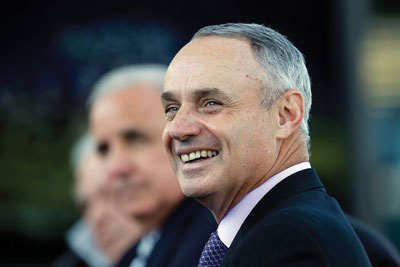 |
MLB Commissioner Rob Manfred has visited more than 20 clubs since January.
Photo by: GETTY IMAGES
|
Many baseball owners considered the first 100 days critical for new Commissioner Rob Manfred, and as he hits that milestone today, the early returns are positive.
“You never have as much opportunity as you do in the first 100 days of an administration. You have the ability to make changes and ask a lot of questions before things get more settled in,” San Francisco Giants President and CEO Larry Baer said. “And that’s precisely what Rob has done. He’s set a number of important initiatives in motion and is off to a very strong start.”
Since succeeding the retired Bud Selig on Jan. 25, Manfred has dramatically remade the league office with a unified executive structure that has seven executives reporting directly to him, ended a long-running business separation between offline and online assets, introduced a new
{podcast}
SBJ Podcast Archive:
From Aug. 18, 2014: Baseball writer Eric Fisher and Executive Editor Abraham Madkour discuss the challenges Rob Manfred faces as the new MLB commissioner.
set of pace-of-play rules, and committed to increased youth participation in baseball, among other moves.
Manfred said that the initiatives are in keeping with priorities outlined during last summer’s election to succeed Selig and that he’ll remain focused on them.
“There were a number of key things, such as pace of play and youth involvement, that I was really anxious to get going on,” Manfred said. “The owners also made a strong statement that they were looking for changes in some key areas, and I think the early returns have been promising.”
Another owner mandate during the election has been for greater transparency from the commissioner’s office. As a result, Manfred has visited in person with more than 20 clubs since January, and plans to finish out the remaining visits in the next several weeks. Even after that process is complete, he said he intends to be on the road frequently. One of those team visits to Baltimore happened to occur coincidentally the same day that civil unrest erupted in the city.
LEADING OFF
Key initiatives for MLB Commissioner Rob Manfred in his first 100 days:
■ Reorganization of the league headquarters. Manfred unified baseball’s previously divided business structure.
■ Realignment of owner committees. Nearly every one was reworked, most notably the executive council.
■ Creation of One Baseball initiative. Manfred set up an umbrella effort seeking to unify nearly every level of youth and amateur baseball.
■ Establishment of pace-of-play rules.
■ Awarding of the 2016-18 All-Star Games. Manfred has done away with the AL-NL rotation in favor of a bid process more like the Super Bowl.
“The travel, once I have seen everybody, will be a bit more issue-driven. But the visibility and contact is very important, and I intend that to be a hallmark of our activities here,” Manfred said.
The pace-of-play rules have shaved about 10 minutes off MLB’s average game time, which surpassed three hours last year. More important to executives throughout the game is the crisper level of play that has been widely apparent.
“We see a difference already,” said Crane Kenney, Chicago Cubs president of business operations. “We’ve made the game more watchable, took wasteful time out, and after a lot of time talking about this issue, we acted on something.”
Manfred still has issues in front of him, many quite thorny. Among them are ballpark woes in Oakland and Tampa, the Mid-Atlantic Sports Network legal dispute between the Washington Nationals and Baltimore Orioles slated to go to oral arguments May 18, and Pete Rose’s bid for reinstatement to baseball. Labor negotiations also will begin next year toward a new deal with the MLB Players Association, and both players and management are eager to see reforms in how amateur players enter the professional ranks and accrue service time and benefits.
But metrics such as league record attendance during spring training, early regular-season attendance also trending upward and a large new sponsorship deal with Esurance announced last week have given Manfred encouragement.
“We’ve gone to market in a whole new way, and I think we’re beginning to see tangible fruit from that,” he said.




